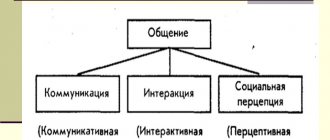| Kind of work: | Essay |
| Date added: | 21.01.2020 |
- This type of work is not a scientific work, it is not a finished final qualifying work!
- This type of work is a finished result of processing, structuring and formatting collected information intended for use as a source of material for independent preparation of educational work.
If you have a hard time understanding this topic, write to me on WhatsApp, we’ll look into your topic, agree on a deadline, and I’ll help you!
If you want to learn how to correctly carry out and write abstracts on any subject, then on the page “what is an abstract and how to do it” I wrote in detail.
Introduction
Business communication is an important part of a person’s life, expressed in the form of relationships with other people. Ethics of business communication is a set of moral norms, rules and views that regulate the behavior and attitudes of people in the process of their production activities. A characteristic feature of business communication is that it is not an end in itself, but serves as a means to achieve any other goals, most often to obtain maximum profit.
Business relationships are a complex, multifaceted process of developing contacts between people in the service sector. Its participants act in official capacities and are focused on achieving goals and specific tasks. A feature of this process is regulation, that is, submission to established restrictions that are determined by national and cultural traditions and the principles of professional ethics. Communication between people is a prerequisite in the process of business relations; I will consider the ethics of business relations using the example of communication and relationships, because with competent communication, the ability to win over the interlocutor also depends on the final result.
Business communication today penetrates into all spheres of public life. Enterprises of all forms of ownership and individuals enter into commercial and business relationships. Competence in the field of business communication is directly related to success or failure in any business: science, art, production, trade. As for managers, entrepreneurs, production organizers, people involved in the field of management, communicative competence for representatives of these professions is the most important part of their professional image.
By nature and content, relationships can be formal (business) or informal. Business relationships are a process of interconnection and interaction in which actions, information and experience are exchanged, involving the achievement of a certain result, the solution of a specific problem or the implementation of a specific goal.
In general, business communication differs from ordinary (informal) communication in that in its process a goal and specific tasks are set that require solutions. In business communication, we cannot stop interacting with a partner (at least without losses for both parties). Business communication can be divided into direct and indirect. Direct business communication has greater efficiency, the power of emotional impact and suggestion than indirect ones; social and psychological mechanisms operate directly in it.
Business Etiquette
Business documents appeared in Russia after the introduction of writing in the 10th century. The first written documents established in the chronicle are the contractual texts of Russian treaties with the Greeks in 907, 911, 944 and 971, and in the 11th century the first Kievan Russian code of laws “Russian Truth” appeared - an original monument of writing, allowing one to judge the development of the legal and socio-political terminology of that time. In the language of “Russkaya Pravda” it is already possible to highlight the peculiarities of the use of words and the organization of speech, which are one of the characteristic features of business style. We are talking about high terminology, the predominance of composition over subordination in complex sentences, the presence of complex constructions with compositional associations “a”, “and”, “yes”, “how”, and non-union chains. Of all types of complex subordinate clauses, the most common are those with clauses (with conjunctions, if any). Russian Pravda already uses terms that indicate the development of legal relations in Ancient Rus': head (killed), head (killed), ear (killer), ear (witness), vira (looted), booty (property), vein (bride price ), kuna (money). Legal terms represent the most important lexical layer of the language of ancient documents.
Concept, structure and functions of business communication
Business communication concept
Ethics is the science of morality and ethics. The term "ethics" was first used by Aristotle (384-322 BC) to refer to practical philosophy that should answer the question of what we should do to perform right moral actions.
Morality is the moral system of ethical values that a person holds. Morality is the most important way of normative regulation of social relations, communication and behavior of people in various spheres of public life - family, everyday life, politics, science, work, etc. Communication is the process of interaction of social subjects: social groups. , communities or individuals in which information, experiences, abilities and performance results are exchanged. Communication is the way of existence of society and people. It is in the process of communication that the socialization of the individual and his self-realization occur.
The specificity of business communication is due to the fact that it arises on the basis of and in relation to a certain type of activity related to the production of a product or business effect. At the same time, the parties to business communication act in formal (official) statuses, which determine the necessary norms and standards (including ethical) of people’s behavior.
Business communication is a necessary part of human life, the most important type of relationship between people. Eternal and one of the main regulators of these relations are ethical norms that express our ideas about good and evil, justice and injustice, the correctness or incorrectness of people’s actions.
Business communication
Business communication consists of business: negotiations, conversations and meetings, as well as public speaking. Thus, business communication becomes a multifaceted process of developing relationships in the world of work. The participants in these relationships achieve their goals and specific objectives through communication, while maintaining their official status.
Maintaining status is specific to a given process. The regulation of business communication and compliance with established rules also remains. These include cultural or national traditions, mentality, professional ethics, public and implicit norms of behavior. Business etiquette forms rules that contribute to the development of relationships between people in the work environment and their mutual understanding.
Business etiquette is divided into two subgroups: communication between employees of equal status and communication with superiors. In both cases, the general rule is to treat all colleagues and partners in a friendly and correct manner, regardless of their personal disposition towards the person. The ability to deal well with people is one of the main factors influencing your success in business, official or service activities. D. Carnegie argued that success depends only 15% on your professional skills and 85% on your ability to work with people.
Means of communication:
- speech;
- language;
- Gestures;
- pantomime;
- Phrases;
- Emotions.
Components of the communication process:
- Message;
- Talk;
- report;
- Point of view;
- It's a compliment.
- Types of business communication:
- Conversations;
- Negotiation;
- Meeting;
- Visits;
- public performance.
Structure and functions of communication
Communicative - involves the exchange of information between communicating people;
Interactive - consists of organizing interaction between communicating individuals (exchange of actions);
Perceptual - means the process of perception and knowledge of each other by communication partners and the establishment of mutual understanding on this basis.
The communicative side of communication (or communication in the narrow sense of the word) consists of the exchange of information between communicating individuals. The interactive side is the organization of interaction between communicating individuals (exchange of actions). The perceptual side of communication means the process of perception and cognition of each other by communication partners and the establishment of mutual understanding on this basis. The use of these terms is conditional, sometimes others are used in a similar sense: in communication, three functions are distinguished - informational and communicative, regulatory and communicative, affective and communicative.
For transmission, any information must be appropriately encoded, i.e. this is only possible using sign systems. The simplest division of communication into verbal and non-verbal using different sign systems. Verbal uses human speech as such. Speech is the most universal means of communication, since the meaning of the message is least lost when transmitting information through speech. We can identify the psychological components of verbal communication - “speaking” and “listening”. The “speaker” first has a certain plan for the message, then he embodies it in a system of signs. For "listening", the meaning of the received message is revealed simultaneously with decoding.
The interactive function is a characteristic of those components of communication that are associated with the interaction of people, with the direct organization of their joint activities. There are two types of interaction - cooperation and competition.
Cooperative interaction means coordinating the strengths of the participants. Cooperation is a necessary element of joint activity, generated by its very nature. One of the most striking forms of competition is conflict.
The perceptual function of communication is the process of people perceiving and understanding each other.
All three aspects of communication are closely interrelated, organically complement each other and constitute the communication process as a whole.
General ethical principles and nature of business communication
Concept of business communication principles
The ethics of business communication must be taken into account in its various manifestations: in the relationship between an enterprise and the social environment, between enterprises, within one enterprise - between a manager and subordinates, between a subordinate and a manager, between people of the same status. The parties to one or another type of business communication have their own characteristics. The task is to formulate principles of business communication that would not only correspond to any type of business communication, but also would not contradict the general moral principles of human behavior. At the same time, they should serve as a reliable tool for coordinating the activities of people involved in business communication.
Thus, the basis of the ethics of business communication should be coordination, and, if possible, coordination of interests. Naturally, if this is carried out by ethical means and in the name of morally justified goals. Therefore, business communication must be constantly tested by ethical reflections that justify the motives for joining it. At the same time, making ethical choices and individual decisions can often be challenging. Market relations provide freedom of choice, but at the same time increase the number of decision options and give rise to a set of moral dilemmas that await business people at every stage of their activities and communication.
Particular attention should be paid to the golden rule of communication ethics: “Treat others as you would like to be treated.” In the negative form in Confucius’ formulation it reads like this: “What you do not wish for yourself, do not do to others.” This rule is applicable to business communication, but in relation to its individual types: “top-down” (manager-subordinate), “bottom-up” (subordinate-leader), “horizontal” (employee-employee) requires clarification.
| Page: 1 of 3 next —> | Go to page: | |
1
Ministry of Higher Education of the Russian Federation
CHELYABINSK STATE UNIVERSITY Troitsk branch Coursework In the discipline:
Topic: “Ethics of business relations”
a group student Checked:
Troitsk 2003
Contents Introduction 3 Chapter 1. Concept, structure and functions of business communication
1.1.
Business communication concept. 6
1.2.
Structure and functions of communication. 7
1.2.1.
Communicative function of communication. 8 1.2.2. Interactive and perceptual functions of communication. 12 Chapter 2. General ethical principles and the nature of business communication
2.1.
The concept of the principles of business communication. 13
2.1.1.
Top-down business communication ethics. 14 2.1.2. Ethics in business communication from the bottom up. 17 2.1.3. Ethics of business communication “horizontally”. 18
2.2.
Ethical and cultural requirements for classroom speaking. 20
2.2.1.
Stages of preparing and conducting a public speech. 21 2.2.2. Ways to give a speech. 23
2.3.
Establishing contact with the audience. 24
2.4.
Posture, gestures, facial expressions of the speaker. 26
Conclusion 28
List of sources used 30
Annex 1
Introduction
Business relationships are a complex, multifaceted process of developing contacts between people in the professional sphere. Its participants act in official capacities and are focused on achieving goals and specific tasks. A specific feature of this process is regulation, i.e. subordination to established restrictions that are determined by national and cultural traditions and professional ethical principles. A prerequisite in the process of business relations is communication between people; I will consider the ethics of business relations using the example of communication, relationships, because With competent communication and the ability to win over your interlocutor, the final result also depends. Business relationships are closely related to communication, the interaction of production activities - this is the most widespread type of social communication. It represents the sphere of commercial and administrative-legal, economic-legal and diplomatic relations. New economic and social conditions encouraged the broad masses of the population to engage in commercial and organizational activities. This circumstance has brought to the fore the need to teach linguistic forms of business communication, the need to increase the linguistic competence of persons entering into social and legal relations and guiding the actions of people. In market conditions, linguistic competence becomes an indispensable component of general professional training for managers, municipal employees, assistants, and managers at all levels. Business communication today penetrates into all spheres of public life. Enterprises of all forms of ownership and individuals enter into commercial and business relationships. Competence in the field of business communication is directly related to success or failure in any business: science, art, production, trade. As for managers, entrepreneurs, production organizers, people involved in management, communicative competence for representatives of these professions is the most important part of their professional appearance. According to the nature and content of relationships, there are formal (business) and informal. Business relationships are a process of interconnection and interaction in which activities, information and experience are exchanged that involve achieving a certain result, solving a specific problem or realizing a certain goal. In general, business communication differs from ordinary (informal) communication in that in its process goals and specific tasks are set that require solutions. In business communication, we cannot stop interacting with a partner (at least without losses for both parties). Business communication can be divided into direct and indirect. Direct business communication has greater effectiveness, the power of emotional impact and suggestion than indirect communication; socio-psychological mechanisms directly operate in it. The topic I have chosen is relevant because the problem of communication ethics in business has recently received a lot of attention; even a separate branch of science has emerged with the same name, which defines itself as interdisciplinary, based on moral theory, management, economics and psychology. The reason for attention to business ethics issues is primarily related to the economic damage that unethical behavior of employees and business partners causes to a company, as well as the environmental, economic and social damage that corporations and individual entrepreneurs inflict on citizens and society as a whole, seeking to reduce costs and increase your competitiveness. The purpose of writing this course work is to examine the topic I have chosen: “Ethics of business relations.” To develop the topic, it is necessary to answer the following questions: give the concept of ethics in business relations in communication, consider the structure and functions of business communication, general ethical principles and the nature of business communication, analyze the ethical and cultural requirements for speaking in the audience, and finally draw a conclusion on the written work. When writing this course work, I used the following sources: A.A. Guseinov’s textbook, Gardariki “Ethics”. The textbook was prepared by the Department of Ethics, Faculty of Philosophy, Moscow State University. M.V. Lomonosov. The uniqueness of the new textbook lies in its non-doctrinal nature. He systematizes ethical knowledge in its objective, generally valid content. The primary emphasis is not on comparisons and internal disputes of different directions, but on the moral concepts, problems, ideas, and conflicts themselves. In doing so, the authors relied on the history of European ethics, moral culture, and modern discussions on moral issues. Designed for students of all humanities and graduate students. It may also be of interest to representatives of other sciences who wish to obtain a generalized idea of the current state of ethics; I also used lectures on the ethics of communication by I. G. Shirokova. The book was created on the basis of lecture notes from Moscow university students. The material in the book is presented extremely concisely and requires systematization and specification. The knowledge acquired in the process of studying this book is very small. Attention is focused on brief concepts and signs of communication ethics; It is very difficult to formulate an approximate structure (plan) of answers to questions that arise during reading, which complicates the process of perceiving the material read. This book is not an alternative to textbooks for obtaining fundamental knowledge; it serves as a guide for passing exams. The textbook for economic universities - Business Ethics by Yu. Yu. Petrunin outlines the main topics, problems, approaches, and concepts of business ethics. Based on classic Western works, the authors adapt a variety of theoretical and practical material to Russian conditions. The manual is intended primarily for management and economic specialties. It will also be useful to business professionals in addressing the ethical issues of business life. Next, I used the book by Fritzsche D., Business Ethics. Global and managerial perspective. The main leitmotif of David Fritzsche’s book: “Ethics is a necessary condition for achieving success in business!” The book examines the ethical issues that arise in complex business relationships, including the problems that company leaders must resolve. Business involves economic relationships among many stakeholders—customers, employees, shareholders, suppliers, competitors, governments, and communities. Often, parties put forward conflicting demands, and a modern manager must take into account their entirety. The main advantage of the book is its concentration on applied management issues. The author reveals in detail the mechanism for making ethically competent decisions and proposes a methodology that allows you to correlate economic, social, technological and other management tasks with ethical standards. The book is equipped with many examples of real situations and test questions for better assimilation of the material. I also used other literature.
Chapter 1. Concept, structure and functions of business communication
1.1.
Business communication concept. Ethics is the doctrine of morality and ethics. The term “ethics” was first used by Aristotle (384-322 BC) to refer to practical philosophy, which should answer the question of what we must do in order to perform the right moral actions. Morality is a system of ethical values that are recognized by a person. Morality is the most important way of normative regulation of social relations, communication and behavior of people in various spheres of public life - family, everyday life, politics, science, work, etc. The most important categories of ethics are: “good”, “evil”, “justice”, “good”, “responsibility”, “duty”, “conscience”, etc. Communication is the process of interaction between social actors: social groups, communities or individuals, in which information, experience, abilities and results of activities are exchanged. Communication acts as a way of being for society and people. It is in the process of communication that the socialization of the individual and his self-realization occur. According to Aristotle, the ability to communicate distinguishes a person from “morally underdeveloped creatures” and from the “superman.” Therefore, “one who is unable to enter into communication or, considering himself a self-oppressive being, does not feel the need for anything, no longer constitutes an element of the state, becoming either an animal or a deity.”1 The specificity of business communication is due to the fact that it arises on the basis and regarding a specific type of activity related to the production of a product or business effect. At the same time, the parties to business communication act in formal (official) statuses, which determine the necessary norms and standards (including ethical) of people’s behavior. Like any type of communication, business communication is historical in nature; it manifests itself at different levels of the social system and in various forms. Its distinctive feature is that it does not have a self-pressing meaning, is not an end in itself, but serves as a means to achieve some other goals. In market conditions, this is primarily about obtaining maximum profit. Business communication is a necessary part of human life, the most important type of relationship between people. Eternal and one of the main regulators of these relations are ethical norms, which express our ideas about good and evil, justice and injustice, the correctness or incorrectness of people’s actions. And when communicating in business cooperation with their subordinates, boss or colleagues, everyone in one way or another, consciously or spontaneously, relies on these ideas. But depending on how a person understands moral norms, what content he puts into them, and to what extent he generally takes them into account in communication, he can make business communication easier for himself, make it more effective, help in solving assigned tasks and achieving goals, and complicate this communication or even make it impossible.2 Taking into account all of the above, the ethics of business communication can be defined as a set of moral norms, rules and ideas that regulate the behavior and relationships of people in the process of their production activities. It represents a special case of ethics in general and contains its main characteristics.
1.2. Structure and functions of communication.
The structure of communication can be approached in different ways; in this case, the structure will be characterized by highlighting three interconnected parties in communication: 3 Communicative - consists of the exchange of information between communicating individuals;
Interactive - consists of organizing interaction between communicating individuals (exchange of actions); Perceptual - means the process of perception and knowledge of each other by communication partners and establishing mutual understanding on this basis. The use of these terms is conditional, sometimes others use them in a similar sense: in communication there are three functions - information-communicative, regulatory-communicative, affective-communicative. Let's look at each function separately. 1.2.1.
Communicative function of communication. During the communication process, there is not just a movement of information, but a mutual transfer of encoded information between two individuals - the subjects of communication. Therefore, information exchange takes place. But people do not just exchange meanings, they strive to develop a common meaning. And this is only possible if the information is not only accepted, but also comprehended. In the context of human communication, communication barriers may arise. They are of a social or psychological nature.4 The information itself emanating from the communicator can be motivating (order, advice, request - designed to stimulate some action) and ascertaining (message - takes place in various educational systems). For transmission, any information must be appropriately encoded, i.e. it is possible only through the use of sign systems. The simplest division of means of communication is into verbal and non-verbal, using different sign systems. Verbal communication uses human speech as such. Speech is the most universal means of communication, since when transmitting information through speech, the meaning of the message is least lost. The verbal communication process model includes 5 elements: WHO? (transmits message) – Communicator WHAT? (transmitted) – Message (text) HOW? (transfer in progress) – Channel TO WHOM? (message sent) – Audience WITH WHAT EFFECT? - Efficiency. Three positions of the communicator during the communicative process can be distinguished: Short-open (openly declares himself a supporter of the point of view being presented); Distant (behaves, emphatically neutral, compares conflicting points of view); Shclosed (remains silent about her point of view, hides it).
In modern communication, it is customary to distinguish 3 types of speech acts, depending on the expected reaction of the addressee: questions, incentives and messages. If no reaction is expected on the part of the interlocutor other than “taking note” of the information, then the statement belongs to the class of message. They must be formulated clearly, concisely, and be truthful. If the expected reaction to a remark is some action outside the framework of the dialogue, then the speaker encourages with speech. A feature of business relationships is that orders and instructions are given in a polite tone. It is better to use this type of incentive, such as a request or advice. A statement aimed at obtaining an answer (verbal reaction) belongs to the class of questions. Depending on the speaker’s attitude, a distinction is made between the actual questions (the questioner himself does not know the correct answer) and the so-called. “teacher’s” questions (the speaker wants to check the addressee of the speech). Any statement, especially a categorical one, evokes a spirit of contradiction. If you give the message the form of a question, you can soften and neutralize the interlocutor’s protest. The question form reduces the likelihood of a dispute or conflict in professional communication. Questions allow a business person to direct the process of transmitting information in the right direction, seize and maintain the initiative, and activate the listener. Based on these functions, there are 5 types of questions: “Closed” - these are questions that can be answered with “yes” or “no”. The trust of the interlocutor can be gained by asking questions at the beginning of contact that require a “yes” statement. “Closed” questions deprive the other person of expressing his opinion; it cannot be abused. “Open” questions require some kind of explanation and are asked to obtain additional information and clarify real motives. They begin with the words “What, who, how, how many, why, what is your opinion...” Rhetorical ones do not require an answer, their purpose is to raise new questions, point out unresolved problems, and provide support for the speaker’s position through tacit approval. Questions for reflection force you to reflect, comment on what has been said, and make amendments to what has been said. Turning questions keep the conversation in a strictly established direction or raise new problems or switch to something else. Nonverbal communication. It has been established that in the process of human interaction, 60-80% of communication is carried out through the use of non-verbal expressions. They develop as social signs of communication, although some of the elements that make them up are innate. Gestures and facial expressions, poses are endowed with semantic-expressive coloring and are subject to ethical standards. In terms of official interaction, the tone of nonverbal behavior should remain neutral. Excessive gesticulation during a business conversation can be regarded as a sign of familiarity. Nonverbal expressions are divided into four groups: Extra- and paralinguistic - various near-speech additives that give communication a certain semantic coloring: type of speech, intonation, pauses, laughter, coughing, etc. Optical-kinetic is what a person “reads” from a distance: gestures, facial expressions, pantomime. A gesture is a movement of the arms or hands; they are classified based on the functions they perform: - communicative (replacing speech) - descriptive (their meaning is understandable only with words) - gestures that express an attitude towards people, a person’s state. Some gestures are arbitrary (rhythmic, pointing, etc.), others are determined by impulses of the subconscious. Facial expressions are the movement of facial muscles. Mastery of facial expressions, the ability to convey emotions (joy, anger, surprise, disgust, fear, sadness...) is a professional requirement for managers, politicians, teachers, and everyone working with people. It is believed that the most expressive are the mouth and lips. Pantomime (kinesics) is a set of gestures, facial expressions and body position in space (postures). Proximics - organization of space and time of the communication process) There are four main communication distances: Shintimnaya - from 0 to 0.5 meters. People who, as a rule, have close, trusting relationships communicate on it. Information is transmitted in a quiet and calm voice. Much is conveyed through gestures, glances, facial expressions; Interpersonal - from 0.5 to 1.2 meters. It allows communication between friends; SHOformal business or social - from 1.2 to 3.7 meters. Used for business communication, and the greater the distance between partners, the more formal their relationship; Public - more than 3.7 meters. Characterized by speaking in front of an audience. With such communication, a person must monitor his speech and the correct construction of phrases. Visual contact - visuals, or eye contact. It has been established that people usually look into each other's eyes for no more than 10 seconds. With the help of our eyes, we receive the most accurate and open signals, therefore, during a business conversation, it is important to control the expression of the eyes, to meet the gaze of the communicant at least 60 - 70% of the time of contact. It is recommended to direct your gaze to an imaginary triangle on the interlocutor’s forehead and not let it go below his eyes. Physiological studies have noted that when a person is satisfied and joyfully excited, his pupils dilate 4 times compared to the normal state, and vice versa. By this sign you can accurately determine the reaction to what you hear. Understanding nonverbal language allows you to accurately determine the intentions and position of your interlocutor.
1.2.2. Interactive and perceptual functions of communication.
The interactive function is a characteristic of those components of communication that are associated with the interaction of people, with the direct organization of their joint activities. There are two types of interactions - cooperation and competition. Cooperative interaction means Coordination of forces of participants. Cooperation is a necessary element of joint activity and is generated by its very nature. One of the most striking forms of competition is conflict.6 The perceptual function of communication is the process of people perceiving and understanding each other. All three aspects of communication are closely intertwined, organically complement each other and constitute the communication process as a whole.
Chapter 2. General ethical principles and the nature of business
communication 2.1.
The concept of the principles of business communication. The ethics of business communication should be taken into account in its various manifestations: In the relationship between an enterprise and the social environment, between enterprises, within one enterprise - between a manager and subordinates, between a subordinate and a manager, between people of the same status. There are specifics between the parties to one or another type of business communication. The task is to formulate principles of business communication that not only correspond to any type of business communication, but also do not contradict the general moral principles of human behavior. At the same time, they should serve as a reliable tool for coordinating the activities of people involved in business communication. The general moral principle of human communication is contained in the categorical imperative of I. Kant: “Act in such a way that the maxim of your will can always also have the force of the principle of universal legislation.” In relation to business communication, the basic ethical principle can be formulated as follows: in business communication, when deciding which values should be preferred in a given situation, act so that the maxim of your will is compatible with the moral values of the other parties involved in the communication, and allows coordination of the interests of all parties.7 Thus, the basis of the ethics of business communication should be coordination, and, if possible, harmonization of interests. Naturally, if it is carried out by ethical means and in the name of morally justified goals. Therefore, business communication must be constantly checked by ethical reflection, justifying the motives for entering into it. At the same time, making an ethically correct choice and making an individual decision is often not an easy task. Market relations provide freedom of choice, but at the same time increase the number of decision options and give rise to a set of moral dilemmas that await business people at every step in the process of their activities and communication. Despite all the problematic nature and difficulty of choosing a moral position, there are a number of provisions in communication, following which you can greatly facilitate business communication, increase its efficiency, and avoid mistakes in the process of interaction with others in business.8 It is necessary to understand that there is no absolute truth in morality and the highest judge among men. When it comes to the ethical lapses of others, one should not make “moral elephants” out of “moral flies.” When it comes to your mistakes, you should do the opposite. In morality, one should praise others and make claims on oneself. The moral attitude of others towards us ultimately depends only on ourselves. When it comes to the practical establishment of moral standards, the main imperative of behavior is “start with yourself.” Particular attention should be paid to the golden rule of communication ethics: “Treat others as you would like to be treated.” In its negative form, as formulated by Confucius, it reads: “What you do not wish for yourself, do not do to others.” This rule also applies to business communication, but in relation to its individual types: “top-down” (manager-subordinate), “bottom-up” (subordinate-manager), “horizontally” (employee-employee) requires specification.
| Page: 1 of 3 next —> | Go to page: | |
| © 2007 ReferatBar.RU — Home | Sitemap | Reference |
Business ethics from top to bottom
In business communication “from top to bottom”, i.e. The golden rule of ethics in relation to a manager towards a subordinate can be formulated as follows: “Treat a subordinate the way you would like to be treated by a manager.” The art and success of business communication are largely determined by the ethical standards and principles that the leader uses in relation to his subordinates. Norms and principles refer to what behavior in a service is ethically acceptable and what is not. These norms relate, first of all, to how and on the basis of what orders the management process is given, what the official discipline that determines business communication is expressed. Without ethical business communication between a manager and a subordinate, most people feel uncomfortable and morally insecure in a team. The attitude of a manager towards his subordinates influences the entire nature of business communication and largely determines its moral and psychological climate.
If there are problems and difficulties associated with injustice, the leader must find out the reasons for this. If we are talking about ignorance, then one should not endlessly reproach a subordinate with his weaknesses and shortcomings. Think about what you can do to help him overcome them. Play to his personality strengths.
If an employee does not follow your order, you need to make it clear that you know about it, otherwise he may think that he tricked you. Moreover, if the manager has not made an appropriate remark to the subordinate, then he is simply not fulfilling his duties and is acting unethically. A comment to an employee must comply with ethical standards. Collect all information on the case. Choose the right form of communication. First, ask the employee to explain the reason for not completing the task; perhaps he will provide facts unknown to you. Make one-on-one comments—you must respect the person's dignity and feelings. Never advise subordinates how to handle personal matters. If the advice helps, you probably won't be thanked. If this does not help, you will be held responsible. Don't get overgrown with pets. Treat employees as equal members and hold themselves to the same standard.
Never give the opportunity to notice that you are out of control if you want to maintain their respect. Follow the principle of fair distribution - the more merit, the greater the reward. Encourage your team, even if success is largely due to the success of the leader himself. Develop self-esteem in your subordinates. A job well done deserves not only material, but also moral encouragement. Take the time to praise the employee again. Trust your employees and admit your own mistakes at work. One way or another, members of the team will find out about them. But hiding mistakes is a sign of weakness and dishonesty.
BIBLIOGRAPHY
- Dorofeeva L.I. Organizational behavior: educational and methodological complex. – Saratov: Saratov source, 2014. – 394 p.
- Izmailova M.A. Business communication: textbook. – 4th ed. – M.: Dashkov and K, 2011. – 252 p.
- Komarova L.V. Technologies of business communication and management activities: textbook. – 2nd ed., stereotype. – M.: Publishing house RAGS, 2010. – 148 p.
- Mkrtychyan S.V. On the issue of the scope of the concepts “business communication” and “business speech” (terminological aspect) // World of Linguistics and Communication. – 2007. – No. 7. – P. 15-19.
- Psychology and ethics of business communication: textbook / ed. V.N. Lavrinenko. – 5th ed. – M.: UNITY-DANA, 2008. – 415 p.
- Spivak V.A. Business communications: theory and practice: textbook for bachelors. – M.: Yurayt, 2014. – 460 p.
- Chernyshova L.I. Business communication: textbook. – M.: UNITY-DANA, 2008. – 416 p.
Attention!
If you need help writing a paper, we recommend turning to professionals. More than 70,000 authors are ready to help you right now. Free adjustments and improvements. Find out the cost of your work
Free estimate
0
Size: 21.26K
Downloads: 129
03/23/17 at 07:24 Author: Sema2016
Liked? Click on the button below. It's not difficult for you
, and we
are pleased
).
To download Abstracts for free at maximum speed, register or log in to the site.
Important! All presented Abstracts for free downloading are intended for drawing up a plan or basis for your own scientific works.
Friends! You have a unique opportunity to help students just like you! If our site helped you find the job you need, then you certainly understand how the job you add can make the work of others easier.
Add a job
If, in your opinion, the Abstract is of poor quality, or you have already seen this work, please let us know.
Ethics in business communication from the bottom up
Knowing how to treat and deal with your manager is just as important as what moral expectations you should make of your subordinates. Without this, it is difficult to find a “common language” with both the boss and subordinates. Using certain ethical standards, you can attract a leader to your side, make him your ally, or you can turn him against you, make him your ill-wisher. Here are some important ethics and principles you can use when communicating with your manager. Try to help the leader create a friendly atmosphere in the team and strengthen fair relationships. Remember, your boss needs this first. Don't try to impose your point of view or command the leader. Make your suggestions or comments tactfully and politely. You cannot order anything from him directly. Do not ask for help, advice, suggestions, etc. "Over the head", directly to your leader's leader, except in emergency cases. Otherwise, your behavior may be perceived as disrespecting or ignoring your boss's opinion or as questioning his competence. In any case, your immediate supervisor in this case loses authority and dignity.
Be friendly
The ethics and culture of business communication are based on your internal and external state. In any situation, no matter how bad you feel, you should keep your face. Smile at the person and speak to him as friendly as possible. Your opponent is not to blame for family troubles, that the bus was late, or that the car didn’t start in the morning.
Minor troubles should not spoil the mood of either you or your colleagues. Thanks to your positive outlook and friendly attitude, you will be known as a kind and open person. This characteristic will allow you to gain the trust of colleagues, clients and superiors. And most importantly, by always being in a good mood, you will develop the habit of positive thinking, which will help you overcome all life's troubles.
Ethics of business communication “horizontally”
The general ethical principle of communication “horizontally”, that is, between colleagues (leaders or ordinary members of the group). If you don’t know how to behave in a given situation, put yourself in your colleague’s shoes. When it comes to fellow managers, keep in mind that finding the right tone and acceptable standards of business communication with colleagues from other departments is not easy. Especially when it comes to communication and relationships within one enterprise. In this case, they often become rivals in the struggle for success and promotion. At the same time, these are people who are part of the CEO’s team with you. In this case, participants in business communication should feel equal to each other. Do not ask yourself for any special treatment or special privileges from another.
Try to achieve a clear division of rights and responsibilities in common work.
If your responsibilities overlap with your colleagues, this is a very dangerous situation. If your manager doesn't differentiate your duties and responsibilities from others, try doing it yourself.
In relationships between colleagues from other departments, you should take responsibility for your department, and not blame your subordinates.
If you are asked to temporarily transfer an employee to another department, do not send unscrupulous and unqualified people there - because there you and your department as a whole will be judged. Remember, it may happen that you are treated in the same immoral way.
Don't prejudice your colleagues. As much as possible, avoid prejudice and gossip when dealing with them.
Call your interlocutors by name and try to do this more often. Smile, be friendly, and use a variety of techniques and tools to show that you are kind to the other person. Remember - what you sow, you reap.
Don't make promises you can't keep. Don't exaggerate your value and business opportunity. If they do not come true, you will not be comfortable, even if there were objective reasons for this.
Don't get into a person's soul. At work, it is not customary to ask personal questions, let alone about problems. Don't try to seem better, smarter, more interesting than you really are. Sooner or later he will still swim out and fall into place. Send impulses of your sympathies - with a word, a look, a gesture, let the participant in the conversation understand that you are interested in him. Smile, look straight into the eyes.
View your colleague as a respected person in his own right, rather than as a means to your own ends.
Posture, gestures, facial expressions of the speaker
Posture, gestures, facial expressions - belonging to an individual style. These elements of the kinetic communication system affect the visual channel of perception, focus attention on the content of information coming through the auditory channel, increase emotionality and thereby contribute to better assimilation of expressed thoughts. According to psychologists, 25% of speech is perceived visually.
The speaker must achieve a sense of stability, balance, lightness, mobility and naturalness on the podium in front of the public. The sight of a person standing motionless for a long time tires the audience. During a long speech, an experienced speaker changes his position. A step forward at the right moment enhances the significance of a particular place in speech and helps to focus attention on it. By stepping back, the speaker allows the audience to “rest” and then moves on to another speaking position. During the performance, you must not walk or step aside. The skill of the speaker is manifested in enhancing the impact with gestures and facial expressions. Excessive virtuosity does not decorate the speaker and causes irony and hostility. It is necessary to distinguish meaningless mechanical gestures from meaningful gestures that contribute to the success of speech (shaking the head, straightening hair, dressing, turning a pen, etc.). It is argued that the best and most perfect gesture is the one that the listeners do not notice, that is, it organically merges with the content of the speech.
Negative and positive gestures:
- The head, as if “pressed” to the shoulders, expresses a feeling of threat and, as a result, defensive behavior: helplessness, fear, nervousness.
- Hands at the sides demonstrate firmness, confidence, stability and superiority of the speaker over others.
- Hands resting on the back of the chair, podium, table shows the desire for any support due to uncertainty.
- Staticity or immobility of the body expresses uncertainty, constraint, isolation, and avoidance of contacts.
Negative gestures during speaking may also include: hands in pockets or crossed over chest, hands clenched into fists, hand over mouth, looking away, passing hand behind chair before sitting down.
You can also highlight gestures that, on the contrary, demonstrate your goodwill towards the public: shrugging your shoulders, turning your hands towards the public with your palms up, unbuttoning your jacket, reducing the distance between you and your interlocutor. These gestures will help you win over your audience and allow them to relax internally.
When speaking, you cannot ignore eye contact with the audience. It plays an important role in establishing non-verbal communication and is a “bridge” of mutual understanding. Before you speak, take another look at each audience to listen to you. And during your speech, select several people from the audience to whom you seem to “address” your thoughts.
The main indicator of the speaker's feelings is his facial expression. The speaker's facial expressions stimulate the audience's emotions and are capable of conveying a range of experiences: joy and sadness, doubt, irony, determination... The facial expression must correspond to the nature of the speech. A good speaker, as A.F. noted. Kony, “the face speaks with a tongue.” The person and the entire appearance of the speaker should convey a friendly and even benevolent attitude. The public does not like those who are angry or indifferent.
Analysis is necessary after a public speaking performance. First of all, to find, highlight and take into account further shortcomings.










